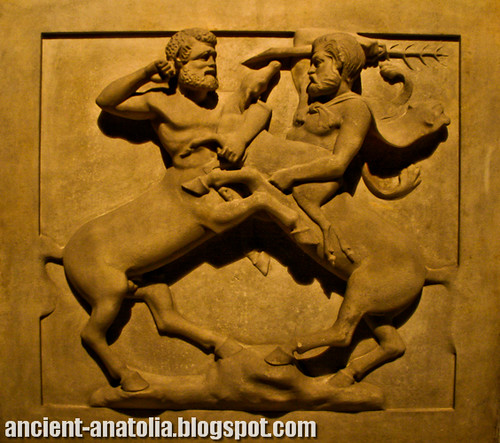
The Battle of Centaurs and Lapiths
The Lycian tomb describing the Battle of Centaurs and Lapiths discovered in the Necropolis of Sidon, among important finds such as the Alexander Sarcophagus, and the Sarcophagus of the Crying Women, which are now on display at the Istanbul Archaeology Museum in Istanbul. This sarcophagus called Lycian sarcophagus due to its resemblance to the sarcophagi of Lycian region, which is the artwork of an ancient Lycian sculptor.

The Lapiths are a legendary people of Greek mythology, whose home was in Thessaly, in the valley of the Peneus and on the mountain Pelion.They were an Aeolian tribe. Like the Myrmidons and other Thessalian tribes, the Lapiths were pre-Hellenic in their origins. The genealogies make them a kindred people with the Centaurs: in one version, Lapithes and Centaurus were said to be twin sons of the god Apollo and the nymph Stilbe, daughter of the river god Peneus. Lapithes was a valiant warrior, but Centaurus was a deformed being who later mated with mares, from whom the half-man, half-horse Centaurs sprang. Lapithes was the eponymous ancestor of the Lapith people, and his descendants include Lapith warriors and kings.
The best-known legend with which the Lapiths are connected is their battle with the Centaurs at the wedding feast of Pirithous, the Centauromachy. The Centaurs had been invited, but, unused to wine, their wild nature came to the fore. When the bride was presented to greet the guests, the centaur Eurytion leapt up and attempted to rape her. All the other centaurs were up in a moment, straddling women and boys. In the battle that ensued, Theseus came to the Lapiths' aid. In the battle the Lapith Caeneus was killed, and the defeated Centaurs were expelled from Thessaly to the northwest.
As Greek myth became more mediated through philosophy, the battle between Lapiths and Centaurs took on aspects of the interior struggle between civilized and wild behavior, made concrete in the Lapiths' understanding of the right usage of god-given wine, which must be tempered with water and drunk not to excess. The Greek sculptors of the school of Pheidias conceived of the battle of the Lapiths and Centaurs as a struggle between mankind and mischievous monsters, and symbolical of the great conflict between the Greeks and the others, barbarians.
In the Iliad the Lapiths send forty manned ships to join the Greek fleet in the Trojan War, commanded by Polypoetes and Leonteus.